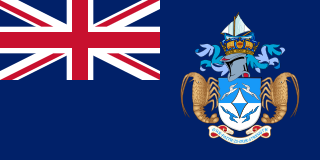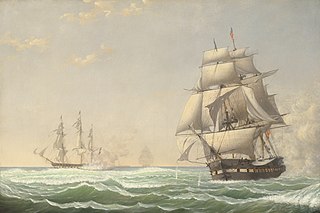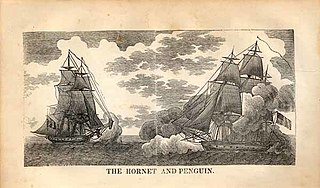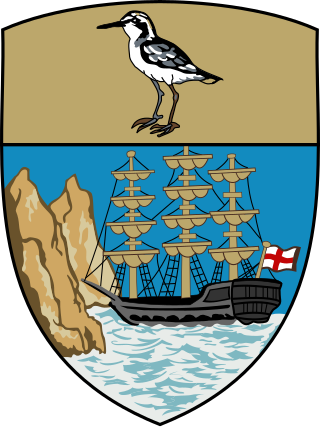
Saint Helena is a British overseas territory located in the South Atlantic Ocean. It is a remote volcanic tropical island 1,950 km (1,210 mi) west of the coast of south-western Africa, and 4,000 km (2,500 mi) east of Rio de Janeiro in South America. It is one of three constituent parts of the British Overseas Territory of Saint Helena, Ascension and Tristan da Cunha.
This article deals with traffic in Saint Helena, Ascension and Tristan da Cunha, that is all forms of traffic in the British overseas territory of Saint Helena, Ascension and Tristan da Cunha.

Tristan da Cunha, colloquially Tristan, is a remote group of volcanic islands in the South Atlantic Ocean. It is the most remote inhabited archipelago in the world, lying approximately 2,787 kilometres (1,732 mi) from Cape Town in South Africa, 2,437 kilometres (1,514 mi) from Saint Helena, 3,949 kilometres (2,454 mi) from Mar del Plata in South America and 4,002 kilometres (2,487 mi) from the Falkland Islands.
Tristan da Cunha is part of the British overseas territory of Saint Helena, Ascension and Tristan da Cunha and has a history going back to the beginning of the 16th century. It was settled by men from military garrisons and ships, who married native women from Saint Helena and the Cape Colony. Its people are multi-racial, descended from European male founders and mixed-race and African women founders.

The British Overseas Territories (BOTs), also known as the United Kingdom Overseas Territories (UKOTs), are fourteen territories with a constitutional and historical link with the United Kingdom, but do not form part of the United Kingdom itself. The permanently inhabited territories are internally self-governing, with the United Kingdom retaining responsibility for defence and foreign relations. All of the territories are inhabited by civilians, except 3 which are chiefly or only inhabited by a population of military or scientific personnel. All fourteen have the British monarch as head of state. These UK government responsibilities are assigned to various departments of the Foreign, Commonwealth and Development Office and are subject to change.

The flag of Saint Helena consists of a Blue Ensign defaced with the shield from the British overseas territory's coat of arms. Adopted in 1984 shortly after the island was granted a new coat of arms, it has been the flag since. Saint Helena's flag is similar to the flags of eight other British Overseas Territories, which are also Blue Ensigns with their respective coats of arms.

Inaccessible Island is a volcanic island located in the South Atlantic Ocean, 31 km (19 mi) south-west of Tristan da Cunha. Its highest point, Cairn Peak, reaches 449 m (1,473 ft), and the island is 12.65 km2 (4.88 sq mi) in area. The volcano was last active six million years ago and is currently extinct.

Nightingale Island is an active volcanic island in the South Atlantic Ocean, 3 square kilometres (1.2 sq mi) in area, part of the Tristan da Cunha group of islands. They are administered by the United Kingdom as part of the overseas territory of Saint Helena, Ascension and Tristan da Cunha.

Edinburgh of the Seven Seas is the only settlement of the island of Tristan da Cunha, a part of the British Overseas Territory Saint Helena, Ascension and Tristan da Cunha in the South Atlantic Ocean. Locally, it is referred to as The Settlement or The Village.

The capture of USS President was one of many naval actions fought at the end of the War of 1812. The frigate USS President tried to break out of New York Harbor but was intercepted by a British squadron of four warships and forced to surrender.

On 23 March 1815 USS Hornet captured HMS Penguin in a short battle off Tristan da Cunha. It was one of several engagements that took place after the War of 1812 had ended, and was the final action between British and American forces. The American gunnery was far more effective than the British, despite the two vessels being virtually identical in strength. After exchanges of broadsides and musket fire, the British commander was killed. The British brig rammed the American ship in an attempt to board, but the two were separated and Penguin was disabled shortly afterwards when the foremast fell, forcing the British to surrender. The British brig was too badly damaged to be salvaged and was set ablaze by the victors after its stores and surviving crew were removed.

The Nightingale Islands are a group of three islands in the South Atlantic Ocean, part of the Tristan da Cunha territory. They consist of Nightingale Island, Middle Island and Stoltenhoff Island. The islands are administered by the United Kingdom as part of the overseas territory of Saint Helena, Ascension and Tristan da Cunha. The Nightingale Islands are uninhabited.

The coat of arms of Saint Helena, part of the British Overseas Territory of Saint Helena, Ascension and Tristan da Cunha, was authorised on 30 January 1984.

Saint Helena, Ascension and Tristan da Cunha is a British Overseas Territory located in the South Atlantic and consisting of the island of Saint Helena, Ascension Island, and the archipelago of Tristan da Cunha. Its name was Saint Helena and Dependencies until 1 September 2009, when a new constitution came into force giving the three islands equal status as three territories, with a grouping under the Crown.
Bengal Merchant was a sailing ship built of teak in Bengal and launched there on 26 May 1812. Between 1812 and 1829, Bengal Merchant was in private trade as a licensed ship. She served the East India Company (EIC) in 1813 and from 1830 till 1834. She also twice transported convicts from Britain to Australia before she was hulked in 1856.

HMS Julia was a British Royal Navy 16-gun brig-sloop of the Seagull class launched in February 1806. After a fairly uneventful decade-long career she was wrecked at Tristan da Cunha in 1817 with heavy loss of life.
Blenden Hall was a full-rigged ship, launched in 1811 at Bursledon, Hampshire, England. A French frigate captured her in 1813, but then abandoned her. After her recovery she returned to trade. She was wrecked in 1821 on Inaccessible Island in a notable incident.
William Glass was a Scottish Corporal and settler. He established the settlement that would become Edinburgh of the Seven Seas, the main settlement on Tristan da Cunha.

Jonathan Lambert was an American sailor. He was the first settler, and the self-proclaimed ruler of the Tristan da Cunha archipelago.











